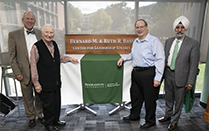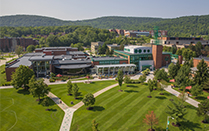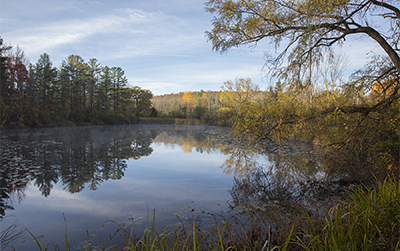
IMPROVING CAMPUS INFRASTRUCTURE
Some of the major improvements to infrastructure completed over the summer are very visible; others are not. Read in this issue about the many major projects completed by Physical Facilities and Information Technology Services, as well as the new programs offered by the University Center for Training and Development.

SCHOOL OF PHARMACY AND PHARMACEUTICAL SCIENCES OPENS NEW BUILDING
The opening of the new, $60-million School of Pharmacy and Pharmaceutical Sciences at the University's Health Sciences Campus in Johnson City, N.Y., headlines this quarterly report, but there's also good news about collaborations, external funding and student successes. Read more in this issue.

SUCCESSFUL INITIATIVES SUPPORT STUDENTS
It takes donors at many levels to make Binghamton University successful, and in this issue of the quarterly report, you can read about a number of them. Whether it's AVANGRID offering full-tuition scholarships and capstone project support, or playing golf to benefit the Alumni Legacy Scholarship, the Division of Advancement works with Binghamton supporters.

BINGHAMTON RESEARCH FUNDING SETS RECORD
Binghamton University reported research expenditures totaling $47.5 million in 2017-18, an increase of about 19 percent from the previous fiscal year. The figure tops 2011-12, the campus’ all-time best year for research funding, when just over $40 million was reported. The new record, which follows several years of steady growth, is an important sign of the campus’ creativity and innovation. Healthcare research accounted for nearly a third of expenditures, with electronics packaging and systems engineering following at about 22 percent.

BAXTER THE BEARCAT BOOSTS SCHOOL SPIRIT
The Division of Student Affairs spent the summer hosting students and families for orientation and preparing for the opening of the fall semester. With some new people on board and some others with new duties, it has been a busy time. Not too busy, though, to show Binghamton University pride, as you'll read about the new Baxter the Bearcat Bench in the University Union in this issue.

STUDENT-ATHLETES CONTINUE TO SUCCEED ACADEMICALLY
Student-athletes continue to shine on and off the courts and fields. The Athletics Department sets high academic standards, and student-athletes surpass them across the board. Read about the accomplishments made by student-athletes in their sports and in the classroom – and check out the videos showcasing fall sports and the new women's head basketball coach, Bethann Shapiro Ord, in this issue.

HELPING TO MAKE THE CAMPUS MORE INCLUSIVE
The Division of Diversity, Equity and Inclusion works to educate and empower everyone on campus in ways that create a welcoming community. From the Udiversity Educational Institute, that holds trainings for students, faculty and staff, to the Multicultural Resource Center and Q Center, the division's offices that work to build bridges and support students though education and events such as Sundaze, part of its Welcome Week programming. Read about the division's recent initiatives in this report.

DONOR SUPPORT ADVANCES BINGHAMTON UNIVERSITY
The Binghamton University Foundation had a successful 2017-18 year, bringing in the second highest amount of cash ever in support of the University. Read the numbers in this issue of the quarterly report, and learn one way the Foundation celebrates its donors.

Binghamton joins Chesapeake Watershed research network
Binghamton University recently joined the Chesapeake Watershed Cooperative Ecosystem Studies Unit (CHWA CESU), a network of nine federal agencies and several dozen research institutions that strive to understand and protect the region’s natural and cultural resources.
Carl Lipo, associate dean for research and programs in Harpur College and director of Binghamton’s Environmental Studies Program, championed the campus’ involvement with the CESU, which was founded in 2001.
“Binghamton has some unique capabilities that will be of value to the Chesapeake Watershed network, especially related to historic preservation, geospatial technology and watershed studies,” says Lipo, who will be the University’s technical representative to the group. “We’re excited to make a contribution to this group and to learn from the other scientists at our partner institutions.”
Binghamton is the only New York school in the network, which also includes Pennsylvania State University, several University of Maryland campuses, Ohio University, the University of Virginia and others. Binghamton’s location along the upper Susquehanna River provides a prime location for the study of natural and cultural resources in the Upper Chesapeake Bay Watershed as well as the rest of the region.
Michael Jacobson, research development specialist in Binghamton’s Office of Strategic Research Initiatives, attended the CESU’s June meeting, held in West Virginia.
“It was great to see the numerous projects already conducted by the CHWA CESU and how well the partnerships work,” Jacobson says. “It gave me some interesting ideas about how Binghamton’s researchers can contribute to the network.”
The research network streamlines the process by which universities learn about federal agencies and opportunities to conduct sponsored research. Research institution partners provide leadership in watershed science and stewardship with special emphasis on the watershed of the Chesapeake Bay.
The Chesapeake Watershed’s 64,000 square miles are home to more than 3,600 species and over 15 million people.